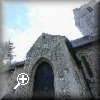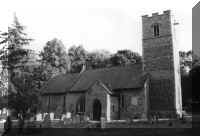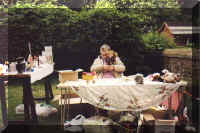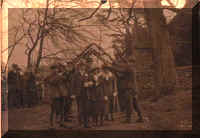St Mary the Virgin - the church in the forest
 St.
Mary's Church in Santon Downham is set in a most tranquil spot on the edge of
the forest at the end of the large village green. The Domesday Book notes the
existence of a church in the village, most probably wooden and replaced by the
present one. The Nave was begun in the 12th century and built towards the east
culminating in the chancel which was finished during the 13th century. The tower
was built between 1460 and 1500 as a result of bequests made by various members
of local families. Interesting to note on the north side of the tower about two
thirds up there is a yellow brick that marks the spot, reputedly, of the level
at which the sand came to rest in the famous sand storm of 1668.
St.
Mary's Church in Santon Downham is set in a most tranquil spot on the edge of
the forest at the end of the large village green. The Domesday Book notes the
existence of a church in the village, most probably wooden and replaced by the
present one. The Nave was begun in the 12th century and built towards the east
culminating in the chancel which was finished during the 13th century. The tower
was built between 1460 and 1500 as a result of bequests made by various members
of local families. Interesting to note on the north side of the tower about two
thirds up there is a yellow brick that marks the spot, reputedly, of the level
at which the sand came to rest in the famous sand storm of 1668.
 This
little church contains some fascinating anomalies: next to the north porch
outside, there is evidence of an additional, or most probably, an earlier
Trinity chapel; there is an arch filled with knapped flint and to the east a
very well preserved piscina, the little niche above the door in the porch is off
centre, indicating that the much thicker east wall of the porch was orginally
the west side of this chapel, most probably destroyed during the Reformation.
Above the south doorway there is a carved stone panel depicting what could be a
wolf (symbolising evil) devouring the tree of life, which, indestructible
sprouts from the wolf's tail - symbolic of the Resurrection? (Similar depictions
may be found on two capitals in the north transept of Ely Cathedral and on the
Norman tympanum of the Tree of Life at Wordwell, 10 miles from Santon Downham).
High up in the south wall of the nave is an arched opening, having in it the
remains of a mediaeval scroll painting, but it bears no relation to anything
else in the church.
This
little church contains some fascinating anomalies: next to the north porch
outside, there is evidence of an additional, or most probably, an earlier
Trinity chapel; there is an arch filled with knapped flint and to the east a
very well preserved piscina, the little niche above the door in the porch is off
centre, indicating that the much thicker east wall of the porch was orginally
the west side of this chapel, most probably destroyed during the Reformation.
Above the south doorway there is a carved stone panel depicting what could be a
wolf (symbolising evil) devouring the tree of life, which, indestructible
sprouts from the wolf's tail - symbolic of the Resurrection? (Similar depictions
may be found on two capitals in the north transept of Ely Cathedral and on the
Norman tympanum of the Tree of Life at Wordwell, 10 miles from Santon Downham).
High up in the south wall of the nave is an arched opening, having in it the
remains of a mediaeval scroll painting, but it bears no relation to anything
else in the church.
Within is a 13th or 14th century font and an early 14th century screen, crude
and heavy in design but with a curious roughly cut double arch in one panel of
the dado, possibly a primitive confessional. The altar cross, candlesticks and
the processional cross all in wood are modern and were made by a local forester.
There are some fragments of mediaeval glass in the South chancel window but
otherwise all the stained glass is Victorian except for the 1952 window in the
south wall of the chancel by Harcourt Doyle.
The memorials relate to the various landowners and their families connected
with the village, notably the Wrights from the 17th and 18th centuries, through
the Cadogans to the last 'squire', Colonel Edward Mackenzie who died in 1929.
Outside in the graveyard, near the gate is to be found the remains of a
mediaeval churchyard cross, from the time when a single cross or crucifix
commemorated all souls.
![The wedding of Albert Carter and Emma Thompson took place at St. Mary the Virgin in 1919 > Simply click to enlarge... then use the [Back] button to return](images/carter2_small.jpg) The
Register of Baptisms, Marriages and Burials dates from 1579 and is complete from
that date.
The
Register of Baptisms, Marriages and Burials dates from 1579 and is complete from
that date.
Sally McIrvine 2oooC
Photograph of Mr.& Mrs. Carterís wedding by Mr. John Fuller.
The Life of The Church
by Andrew and Margaret Kedar.
Running an ancient village church involves considerable time and expense. It
is a task that is all the harder in a tiny village, with few people to share the
load. The burden of preserving the most important building in the parish falls
on a few households, explained Churchwarden and treasurer Andrew Kedar. Most do
not wish to pay.
There is much to do in the upkeep of the church and churchyard. Cleaning,
repairing, flower arranging and security of the very valuable building is in the
hands of about six people. Two of these, Andrew and Margaret Kedar, described
the day-to-day tasks and fundraising, as well as the special events in the
church's calendar, in an interview in October 1999.
Although the congregation is small, the village and church are popular with
visitors. "We do anything to keep the church open," said Margaret.
"We have had one incident of vandalism, but we have been very lucky. Unlike
a lot of churches in England and around Suffolk, we can keep the church open in
daylight hours which is a great bonus." Hundreds of visitors visit each
year, and there are pages of laudatory comments about the church.
Churchwardens play an important part in the running of St Mary's. "You
are responsible for the upkeep of the church, the running smoothly of the
services and generally for the well being of the whole set-up of the church
congregation in a way - you just keep an eye on them," explained Margaret
who has recently completed a seven year term in the role. The current Wardens
are Andrew Kedar and Heather Brighouse.
The church was begun in the 12th century, though there was probably a church
there long before that as bodies have been uncovered in the churchyard dating
back 1000 years. The church developed in a rather random way, and the latest
addition which can be accurately dated is the tower, built between 1460 and
1503. A booklet about the church's history, written by John Fitch, is on sale in
the church.
There is a weekly Sunday service in Santon Downham, even though the village
shares its rector with two other parishes, explained Margaret. The Rector
usually visits twice a month, for a Eucharist service. Family services are taken
by a Churchwarden, or by Ann Buttrey, a lay reader who lives in Brandon.
"We are also very fortunate in that we have a retired priest, the Reverend
John Terry, who will come an average of once a month," she added.
Special services were arranged to mark the third millennium. "There will
be the usual Christmas services of course," said Margaret, "but on the
1st January there will be a special service at which we shall probably ring in
the bell around midday to welcome in the new year. We are also going to plant a
millennium yew tree. This is a small 18 inch high tree which has been taken from
yew trees with a history of over 2000 years. So it's come from a parent tree
which is as old as Christ."
Day to day tasks
"We are very fortunate too because most of our upkeep is done by
voluntary help," said Margaret Kedar.
Churchyard maintenance is relatively straightforward - just grass cutting -
but is a task that needs to be shared as it is time consuming to mow the half
acre area by hand. A rota of 12 people take turns right through the summer.
The church too is kept very clean by two ladies, Margaret Norton and Sue
Benton who take it in turns. There is also a rota of about six or seven ladies
who do the flowers in the church each week. " Everybody does their own
thing and it always looks nice," said Margaret. "For church festivals
- Christmas and Harvest - we all get together and the whole church is decorated
and it is appreciated by all our visitors. And we who do it also enjoy doing it,
it's a time when we are working quietly in the church."
Rene Abigail, who runs the village shop, is the organist. "She is a
wonderful person and every Sunday plays the organ for us - a lovely variation of
hymns - nice old ones, plus a few new ones," said Margaret.
The need for funds
Money has to be raised both to keep the building in good repair, and to
contribute as much as £6,000 a year to help pay for the Rector and other
administrative costs of the Diocese.
In essence, the Parochial Church Council has to find about £120 from every
household in the parish (about 95), explained treasurer Andrew Kedar.
One of the biggest costs is the annual insurance premium. "We're insured
for about £450,000 and this year's premium payment was £745 - quite a lot of
money to find," he said. The real value of the building is a lot higher,
but the £450,000 would create a building adequate in size to cater for the
village.
The building is inspected by an architect every five years who then specifies
work to be done to preserve the Grade II building in good repair. "We've
just completed last year, in 1998, about £19,000 worth of repairs which so far
we have paid for ourselves. But towards the end of last year we were given a
grant by the Suffolk Historic Churches Trust of £3,000 and this of course will
go towards the work." Subsidies are not generally available, added
Andrew. Another inspection is now due. "There will be another whole pile of
jobs to do to put the church right as far as the architect is concerned."
"We also have heating costs, lighting costs, wine and wafers, and
there are always little repair jobs - lots and lots of little repair jobs apart
from the big five yearly stint of repairs."
A further burden is that the full value added tax of 17.5% has to be paid on
the work in the church and the churchyard. "We always think this is a
shame, because we are preserving a historic building."
Just a handful of folks supporting the church have to sustain the wonderful,
classical building, he stressed.
Fundraising to run the church
Tea and cakes are on sale in the churchyard every Sunday in summer, as they
have been since 1974. This is done to raise money for the church, and 1999 was a
particularly successful year. "We have - along with donations given to us -
raised almost £850 by the teas," said Andrew Kedar.
 Refreshments
aren't all that is on sale. Thelma Thompson has a stall just outside the church.
"Bric-a-brac is given to her - books, and brass and all kinds of things, to
sell at the church," explained Andrew. She made over £400 in 1999, and
together with proceeds from a coffee morning, her total was almost £580.
Refreshments
aren't all that is on sale. Thelma Thompson has a stall just outside the church.
"Bric-a-brac is given to her - books, and brass and all kinds of things, to
sell at the church," explained Andrew. She made over £400 in 1999, and
together with proceeds from a coffee morning, her total was almost £580.
"Our average in past years has been around £1,000, from teas and
Thelma's stall," said Andrew.
There are wall boxes in the church for visitors who wish to help. "This
year in the wall box we will probably receive between about £300 and £400,
which is an excellent help - I am also the treasurer!" said Andrew.
There have also been occasional flower festivals, mainly to raise money, but
also to encourage people to come into church.
Then there is carol singing. "On two nights before Christmas -
hopefully with good weather - we go round the village trying to visit each house
carol singing," said Margaret. "The money that we raise is
given to St Mary's, mainly for the preservation of the building." The
carol service in the church also acts as a fund raising day - there may be 100
people there - the average attendance for a Sunday service is about 21 or 22.
Fundraising for charity
The churchgoers also raise money for charities, in addition to finding the
funds they need to run St Mary's.
The harvest festival service - when people give the usual harvest produce -
is followed by a harvest supper. "We move a bit of furniture around and
we manage to seat around 40-45 people and we have the supper where people
produce goodies to eat," explained Margaret Kedar. "This year
we raised in the one evening just over £300 which we sent to the Red Cross,
following the Turkey earthquake."
The other main charity that the church supports is the Children's Society.
Each year there is a house to house collection, and people keep boxes in their
houses throughout the year. "Over the last 10 years we have raised about
£2500 for the Children's Society," said Margaret.
Births, marriages and deaths It's always quite difficult getting the village
folk to come to church, said Margaret. "It's their church in times of
christenings and funerals but it's quite hard encouraging them to come a lot of
the time." Typically, the Sunday service is attended by about 21 or 22
people.
Two or three people are normally buried in Santon Downham in a year. The
churchyard itself was extended in 1964 - the previous burial ground was getting
quite full, but the new section which was consecrated in 1964 will take some
years to fill.
There is sufficient space in the churchyard for the parish. "Folks from
outside can't automatically come and be buried here," explained Andrew
Kedar. They have to be either a member of the parish, or the Electoral Roll.
"We still have a small piece of ground as yet untouched - wild scrub ground
- which also belongs to the church, given to us by the Forestry
Commission."
 Weddings,
are even fewer than funerals. The average is two a year. The registers of
burials and baptisms in the church were opened in 1813 and are still in use.
They will one day go to the record office in Bury St Edmunds.
Weddings,
are even fewer than funerals. The average is two a year. The registers of
burials and baptisms in the church were opened in 1813 and are still in use.
They will one day go to the record office in Bury St Edmunds.
The folks who are allowed to be married at St Mary's are mostly those who are
resident in the village, explains Andrew. There are cases of special licences.
And some people who have relatives in Santon Downham may quote their address as
the place of residence provided they do reside there for some time before the
wedding itself.
"We've had some wonderful weddings here," said Andrew. No
very glamourous ones, they've all been very local. In fact I should say that
three of my children have been married in this church over the years, now living
well away. But we've had others as well. In the year that one of ours was
married, there were six weddings." That was a record for the church,
right back to the start of the register in 1813. "Weddings, lovely
occasions," he added. "The ladies come together, arrange
flowers and it all looks quite magnificent."
All Saints - the little church across the river
The team from St Mary's also had responsibility for another church in the
small Norfolk parish just across the river about a mile away, in Santon,
sometimes known as Santon Warren.
The little church of Santon is called by some "St Helen's", but
officially it is called All Saints, explained Andrew Kedar. All Saints is
again a very small church. Until middle of the 1950s, the rector had two
parishes, Santon Downham and Santon, before we merged with Brandon.
"The small church at Santon was made redundant for our uses because
we simply couldn't upkeep the church, there was not enough money to keep both
churches running. In August 1998 it passed out of our hands, and is leased to
the Norfolk Churches Trust.
With limited funds, they keep it open and look after it as best they can.
It has an unusual octagonal tower, but not the same depth of history as
Santon Downham. The first part of it was built in 1628, though there may have
been a church there earlier. It then went into decay until the second part was
built in the mid 19th century by Reverend Weller-Poley, who was a rector of
Brandon as well, and had this as a kind of private chapel.
Andrew and Margaret Kedar interviewed by Veronica Moran.
Written account transcribed by Lisa Russell
The audio recording will be kept at the Bury Records Office.